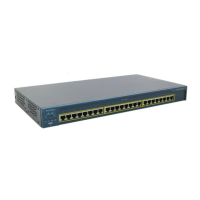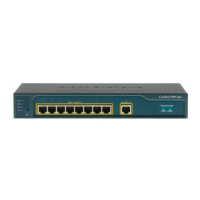13-6
Catalyst 2950 Desktop Switch Software Configuration Guide
78-11380-03
Chapter 13 Configuring QoS
Understanding QoS
Youcreateaclassmapbyusingtheclass-map global configuration command or the class policy-map
configuration command. You should use the class-map global configuration command when the map is
shared among many ports. When you enter the class-map global configuration command, the switch
enters the class-map configuration mode. In this mode, you define the match criterion for the traffic by
using the match class-map configuration command.
You create and name a policy map by using the policy-map global configuration command. When you
enter this command, the switch enters the policy-map configuration mode. In this mode, you specify the
actions to take on a specific traffic class by using the class or set policy-map configuration and
policy-map class configuration commands. To make the policy map effective, you attach it to an interface
by using the service-policy interface configuration command.
The policy map can also contain commands that define the policer, the bandwidth limitations of the
traffic, and the action to take if the limits are exceeded. For more information, see the “Policing and
Marking” sectiononpage13-6.
A policy map also has these characteristics:
• A policy map can contain multiple class statements.
• A separate policy-map class can exist for each type of traffic received through an interface.
• A policy-map configuration state supersedes any actions due to an interface trust state.
For configuration information, see the “Configuring a QoS Policy” section on page 13-13.
Policing and Marking
Note This feature is available only if your switch is running the enhanced software image.
Policing involves creating a policer that specifies the bandwidth limits for the traffic. Packets that exceed
the limits are out of profile or nonconforming. Each policer specifies the action to take for packets that
are in or out of profile. These actions, carried out by the marker, include dropping the packet, or marking
down the packet with a new value that is user-defined.
You can create this type of policer:
Individual—QoS applies the bandwidth limits specified in the policer separately to each matched
traffic class. You configure this type of policer within a policy map by using the policy-map
configuration command.
For non-IP traffic, you have these marking options:
• Use the port default. If the frame does not contain a CoS value, assign the default port CoS value to
the incoming frame.
• Trust the CoS value in the incoming frame (configure the port to trust CoS). Layer 2 802.1Q frame
headers carry the CoS value in the three most-significant bits of the Tag Control Information field.
CoS values range from 0 for low priority to 7 for high priority.
The trust DSCP configurations is meaningless for non-IP traffic. If you configure a port with this
option and non-IP traffic is received, the switch assigns the default port CoS value and classifies
traffic based on the CoS value.

